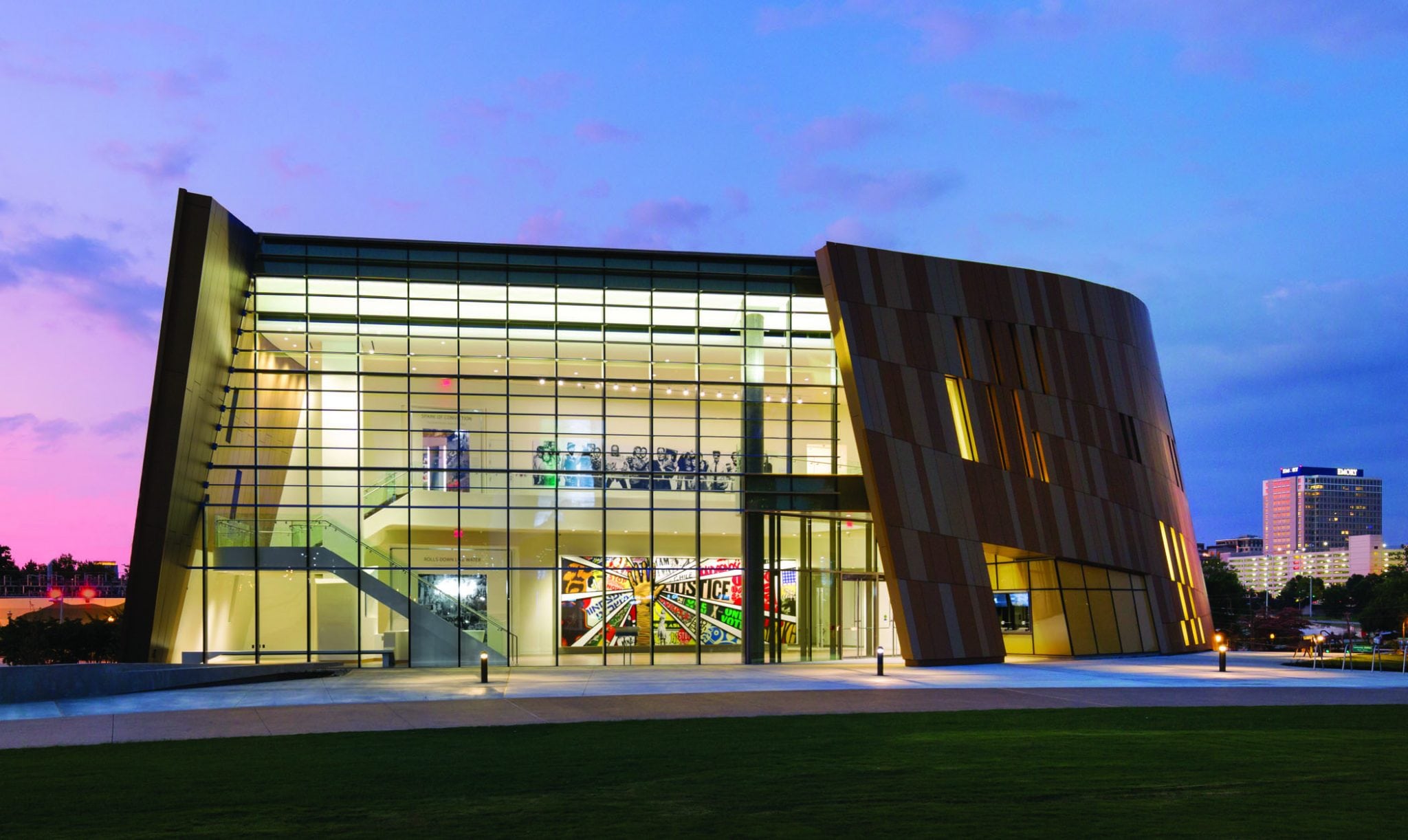The Rise of Civil Rights Tourism in America’s Deep South

Skift Take
Over the past three years, new and newly revamped civil rights museums have appeared across the Deep South, proving to be popular tourist attractions and economic engines.
But this is not happening without difficulty. Historically, due to the horrific and humiliating nature of slavery and the post-Civil War Jim Crow era, the South has been very slow to publicly recognize these atrocities, much less build expensive museums on the subject to attract local or far-away visitors.
According to studies conducted by Mandala Research, African American travelers spend $48 billion worldwide each year and are among the fastest growing traveler groups in the U.S. — 68 percent of African American travelers would like to learn more about African American history and culture while traveling.
Many southerners have feared that shining a light on the region's pre-civil rights past will bring a new wave of blame their way, but now the tourism benefits are hard to pass up. Civil rights tourism could be an economic lifeline, but it requires confronting some ugly truths.
Success Stories Present and Past
Memphis, Tennessee was among the first southern cities to participate in this trend with the National Civil Rights Museum, located at the Lorraine Motel, the site of Dr. Martin Luther King Jr.’s 1968 assassination. While the museum was established in 1991, it underwent a big renovation in 2013 and 2014 costing $27.5 million. It attracted more than 250,000 visitors in 2015, up 27 percent from the year before, and its income rose sharply to more than $4 million in 2015.
Faith Morris, the museum’s chief marketing and external affairs officer, said of the new civil rights museums, “It’s a sign of the times. Folks are still fighting for voting rights, that’s in the news right now. We’ve got modern-day slavery going on right now.” The museum conducts security screenings for visitors, and Morris noted that they were not a direct result of the 2015 Charleston church shooting, but a necessary precaution in general these days.
Tennessee’s Department of Tourist Development website leans heavily on musical star power, from Dolly Parton to Elvis. However, the website does have a fairly hidden section called “African American Heritage” that includes the newly remodeled National Civil Rights Museum. The department reported having no data on civil rights tourism in the state. Also, the museum’s website does not hook into a broader travel experience that might include nearby restaurants and hotels.
Morris noted that the museum values a diverse administration because the civil rights movement itself was diverse. Regarding honesty and transparency, Morris said that “we wanted to make sure that we absolutely got it right. People always remark about how honest the content is. We don’t call it a historical movement, it’s kind of the blueprint for some of the things that we’re trying to get done still.”
Atlanta, Georgia saw the opening of its National Center for Civil and Human Rights in 2014. The facility sits on land donated by Coca-Cola and cost $103 million to build. It’s also located strategically next to the Georgia Aquarium and the World of Coca-Cola museum and entertainment complex. Unlike Memphis’ museum, Atlanta’s is incorporated into a larger city experience. The World of Coca-Cola website openly advertises the city’s broader offerings, as does the museum’s website, which also lists preferred hotels at a discount, hoping to lengthen visitors’ stays.
Doug Shipman, who is on the museum’s board of directors, explained to CNN: “If someone goes to one [attraction] and they're inspired, it makes them more likely to go to another. Civil rights and human rights should be Atlanta's signature, destination topic, like New Orleans and jazz.”
Georgia’s Official Tourism and Travel website has a hard-to-find page called “Must-See Civil Rights Sites” that highlights the National Center for Civil and Human Rights up top, but the website overall relies on old southern tourism favorites like antebellum architecture, which is frequently discussed without really touching the subject of the slave labor that built these landmarks.
Atlanta's positioning is leading the way for new attractions.
In September Washington, D.C. will open the new Smithsonian National Museum of African American History and Culture. At a cost of $540 million to create, this enormous project has been in the works since Congress established it in 2003. Not only is the museum attached to the prestigious Smithsonian brand, a theater inside is named after Oprah Winfrey, who donated $13 million to the project, and the museum sits adjacent to the Washington Monument, right in the middle of tourist central.
In 2017 Montgomery, Alabama will see the nation’s largest and most comprehensive — by far — memorial and museum dedicated to the victims of lynching, created by the Equal Justice Initiative.
Kiara Boone, EJI's deputy program manager, reported that the current fundraising goal for the memorial and museum together is $20 million. When asked about tourists who are already coming to Alabama for its existing civil rights sites, she noted “we’re hoping to definitely tap into those audiences.”
Regarding similar tourism efforts abroad, Boone said, “We think about reconciliation commissions in Africa and holocaust museums around the world that invite an understanding of those crimes and those impacted, and it dares us to never forget what happened." EJI plans to address myriad topics including slavery, racial terror lynchings, and mass incarceration, and discuss "why it’s necessary to have these spaces... to acknowledge the past and try to move forward."
Alabama’s Tourism Department website promotes civil rights tourism more openly than many of its neighboring states’ websites. Alabama’s website has a dedicated section called “Civil Rights Legacy” and offers a free, smoothly designed app that features music, iconic photography, brief biographies, historical information, maps, and logistical details to orient the visitor. One could argue that Alabama doesn't have a great wealth of tourist attractions unrelated to civil rights, unlike Florida for example, whose tourism industry is very robust without civil rights tourism.
Birmingham, Alabama has had the Smithsonian-affiliated Birmingham Civil Rights Institute since 1992, though in 2015, the organization welcomed a new high-profile CEO, Andrea L. Taylor, a former executive at Microsoft. The facility is also undergoing a restoration anticipated to be finished in 2017.
Alabama is home to 11 National Park Service sites related to civil rights, far more than any other southern state. The next most populous is Georgia with four such sites.
Even the unlikely city of Jackson, Mississippi is planning to open the Mississippi Civil Rights Museum in December 2017. The museum is being paired with — or arguably diminished by — a general state history museum. According to Christopher Goodwin, director of public information, the possibility of a standalone civil rights museum was not in the works as far as the Mississippi Department of Archives and History's involvement. Notably, this will be the nation's first state-constructed and state-operated civil rights museum.
In an interview with Al Jazeera America, Democratic State Senator John Horhn reported that state funding was very hard to secure: “I’ve not had in my 21 years being in the [state] Senate an experience where 10 different conference reports were drawn up for presentation to the Senate that were not brought to the floor,'' he said. "It was the 11th time that was the charm.”
Mississippi could have embraced black heritage tourism long ago, but the state’s leadership clung to white supremacy long after the Civil Rights Act of 1964, and long after many of its southern neighbors gave up the ghost.
Mississippi’s official tourism website doesn’t have a dedicated page for black heritage and its extremely short synopsis of “African-American history” glosses over slavery and Jim Crow entirely. The state never quite established a civil rights trail of the same scope as Alabama next door.
If any state could use new jobs and cash flow from an underutilized industry like tourism, it would be Mississippi, which has been ranked numerous times as the poorest state in the nation. According to the U.S. Census Bureau’s latest data from 2010, 21.5 percent of the state’s residents live below the poverty line.
Haley Fisackerly, CEO of Entergy Mississippi, a major backer of the Mississippi Civil Rights Museum, recognized the economic value of tourism in a promotional video: “Much of economic and community development today revolves around the concept of creating experiences for visitors and competing for their travel dollars. The two museums will be a catalyst for creating opportunities to encourage people not only to spend their dollars here in the city of Jackson, but to seek other venues and opportunities throughout the state.”
Mississippi’s museum leadership expects both new museums together will attract 180,000 visitors annually with an annual economic impact of more than $17 million. Thus far the state legislature has invested $74 million in the project.
Charleston, South Carolina is planning an International African American Museum for 2019, aiming for $75 million in funding. Just over a year ago, Charleston was dominating national news because of a church shooting that claimed nine black victims. It brought back painful memories of the 1963 Birmingham church bombing. Now, the city is publicly acknowledging this type of history.
By comparison, Louisiana appears to suffer from a dearth of civil rights tourism. The state is home to zero civil rights-related National Park Service sites and there’s no blockbuster museum to rival the aforementioned multi-million-dollar projects.
Louisiana’s Office of Tourism website includes a map of small African American heritage sites. New Orleans dominates much of the state’s tourism, focusing on jazz, and cajun and creole food.
A Louisiana Civil Rights Museum has theoretically been in the works for years, but has not materialized. Marvin McGraw, a spokesperson for the Louisiana State Museum, with which the civil rights museum would be affiliated, declined to comment on the viability of the project.
Greensboro, North Carolina’s International Civil Rights Center and Museum opened in 2010, focusing on the famous 1960 sit-in by four black students at a whites-only Woolworth lunch counter. The museum contains a portion of the counter still in its original location. In 2014 the museum attracted more than 70,000 visitors, but it has also received some negative news coverage that questioned the museum's financial stability.
When asked about the controversy, museum CEO John L. Swaine reflected on the idea that even today, not everyone welcomes a civil rights museum. Swaine mentioned "a sustained campaign of disparagement against the museum. Even though the wonderful and increasing collection of institutions focused on civil rights — the struggles and the gains — has become an attractive theme for visitors from other places, and sometimes locally as well, this particular set of tourist destinations also may provoke dissonance and discord. There is so much more to do."
North Carolina’s Official Travel and Tourism website has a brief page for combined “African-American and Cherokee History" that highlights the museum, though the department had no specific data on civil rights tourism to the state.
Like Louisiana, Florida lacks a big, attention-grabbing civil rights museum, though of all the states that touch the deep south, Florida has the largest tourism industry, which hinges on beaches, theme parks, cruises, and other sectors that are separate from civil rights history.
Florida has no acute economic need to acknowledge its sizable role in slavery and Jim Crow because the local tourism industry is already thriving, at least in the southern part of the state.
Overall, with the exception of Alabama, most state tourism boards in the Deep South haven't really gotten on the bandwagon of civil rights tourism, though this could soon be changing.
A state’s economy clearly stands to benefit from an influx of tourism dollars — which includes money spent on retail, restaurants, and hotels — as well as new jobs created by these new museums.
Theoretically, the social benefits are significant as well. The acknowledgement of past crimes and the honoring of victims goes a long way toward educating the public and, in an ideal situation, partially healing racial divides. Not having these institutions is potentially one way to deny and forget. However, a museum's social success hinges on presenting an honest, forthright, and transparent view of history.
Alabama’s forthcoming memorial for the victims of lynching could set a crucial example for honesty. Based on the digital rendering, mission, staff expertise, and black leadership at the Equal Justice Initiative, the memorial likely will be painfully honest. Theoretically, its very existence puts lynching in the public eye like never before, and forces the public to consider the sheer number of black people murdered: more than 4,000 lynched in the U.S. between 1877 and 1950, according to EJI.
Mississippi’s museum may be one to watch in terms of content quality. Katie Blount, director of Mississippi’s Department of Archives and History, said in a promotional video for the upcoming civil rights museum: “Mississippians are telling our own stories, we’re doing it honestly, telling these stories in all their complexity.” But the viewer has every right to wonder how the state, which controls the museum's funding and operations, will handle such a contentious issue.
Michael B. Moore, CEO of Charleston’s forthcoming museum, said in an interview with Live 5 News: “African Americans haven’t always been in control of our story, and so we want to create a space that talks about what happened.”
As these big museums continue to open and renovate, we may see the American South honestly discussing civil rights history like never before, and making it an indispensable part of their long-term tourism projects.




